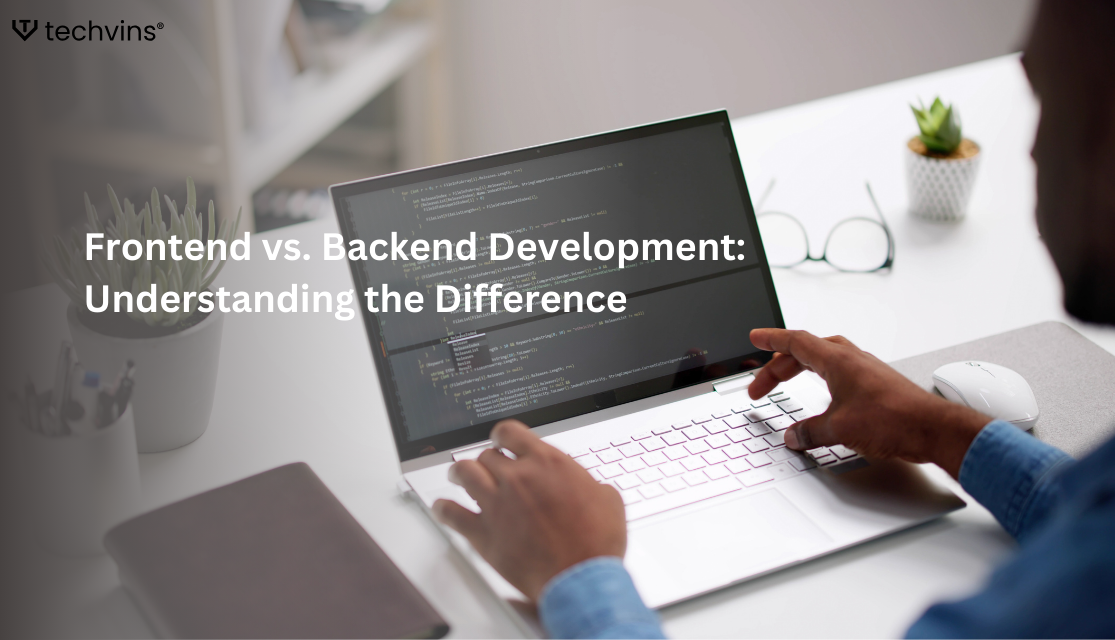Frontend vs. Backend Development: Understanding the Difference

The words "frontend" and "backend" are crucial to comprehending how websites and applications are constructed in the field of web development. With their respective emphasis on various facets of a website or application, these two domains reflect discrete phases of the development process. Backend development makes sure that everything functions properly behind the scenes, whereas frontend development handles everything that the user interacts with directly. Regardless of your level of experience or desire to learn more about web development, it is essential to comprehend the distinction between the two.
1. What is Frontend Development?
Everything that users directly interact with on a website or application is included in frontend development, sometimes referred to as client-side development. This covers the layout, design, and user interface components including text, menus, and buttons. Frontend developers build responsive, aesthetically pleasing, and user-friendly websites using technologies like HTML, CSS, and JavaScript. Their objective is to guarantee that the website works properly on various devices and browsers in addition to being aesthetically beautiful.
2. What is Backend Development?
The portion of web development that concentrates on the unseen backend operations is known as server-side development or backend development. Managing databases, server communications, and application logic are all included in this. Python, Java, Ruby, PHP, and other programming languages are used by backend developers to create and manage the infrastructure that underpins websites and applications. The backend makes sure that everything functions properly behind the scenes and that the frontend gets the right data.
3. Key Technologies in Frontend Development
The three main technologies used by frontend developers are HTML, CSS, and JavaScript. A webpage's content is organized using HTML, styled using CSS (colors, fonts, and layouts), and made interactive with JavaScript (buttons, forms, and dynamic content). Furthermore, frameworks such as Vue, Angular, and React.JavaScript is frequently used to speed up the creation of intricate user interfaces.
4. Key Technologies in Backend Development
A range of server-side programming languages and technologies are necessary for backend development. Python, Java, Ruby, and PHP are common languages that offer a variety of frameworks to assist developers in creating effective backends. In order to store and manage data, backend developers also use databases like MySQL, PostgreSQL, or MongoDB. Furthermore, APIs (Application Programming Interfaces) facilitate efficient communication between the frontend and backend.
5. Roles and Responsibilities
Frontend developers are in charge of making an application's user-facing components, making sure the design is user-friendly and that it functions properly on all devices. They place a lot of emphasis on the design of user interfaces (UI) and user experiences (UX). In contrast, backend engineers are in charge of making sure the system works and performs well. They ensure that everything is safe, scalable, and functional by managing the server, databases, and logic that underpins the frontend.
6. Collaboration Between Frontend and Backend Developers
Despite having diverse areas of expertise, frontend and backend developers need to collaborate closely to produce a seamless online experience. While the backend depends on the frontend to provide this data in an approachable way, the frontend depends on the backend to retrieve and show data. For the user interface and the underlying infrastructure to function together flawlessly, these two domains must effectively communicate and collaborate.
Conclusion
Both frontend and backend development are essential for building useful and captivating apps and websites. Backend development makes ensuring that all of the backend operations function effectively, while frontend development concentrates on the design and user experience. Together, they serve as the cornerstone of contemporary web development, and both fields call for specific knowledge and teamwork. Aspiring developers can choose their area of specialization and help meet the growing demand for qualified experts in the tech industry by being aware of the differences and functions between frontend and backend development.
- Questions and Answers
- Opinion
- Motivational and Inspiring Story
- Technology
- True & Inspiring Quotes
- Live and Let live
- Focus
- Art
- Causes
- Crafts
- Dance
- Drinks
- Film/Movie
- Fitness
- Food
- Games
- Gardening
- Health
- Home
- Literature
- Music
- Networking
- Other
- Party
- Religion
- Shopping
- Sports
- Theater
- Wellness
- News
- Culture


